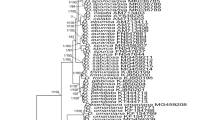Abstract
Survey of seven strains determined as Septonema ochraceum (Dothideomycetes, inc. sed.) isolated from pine litter or obtained from public collections revealed three new species, Fusicladium cordae, F. sicilianum (Venturiaceae), Cladophialophora matsushimae (Herpotrichiellaceae) and a cryptic species morphologically identical to Devriesia americana (Teratosphaeriaceae), but phylogenetically distinct. Morphological survey and phylogenetic analysis using nucleotide sequence data from the nuclear ribosomal subunit genes indicate a close relationship within three species colonising pine litter needles, F. cordae, F. pini and F. ramoconidii. F. sicilianum is most related to F. rhodense. C. matsushimae represents a species belonging to one of the lineages of the polyphyletic genus Cladophialophora. None of the strains observed can be classified morphologically as S. ochraceum, of which the type material does not exist.





Similar content being viewed by others
References
Altschul SF, Madden TL, Schäffer AA, Zhang J, Zhang Z, Miller W, Lipman DJ (1997) Gapped BLAST and PSI-BLAST: a new generation of protein database search programs. Nucleic Acids Res 25:3389–3402
Crous PW, Schubert K, Braun U, de Hoog GS, Hocking AD, Shin H-D, Groenewald JZ (2007a) Opportunistic, human-pathogenic species in the Herpotrichiellaceae are phenotypically similar to saprobic or phytopathogenic species in the Venturiaceae. Stud Mycol 58:185–217
Crous PW, Braun U, Schubert K, Groenewald JZ (2007b) Delimiting Cladosporium from morphologically similar genera. Stud Mycol 58:33–56
Fassatiová O (1986) Moulds and filamentous fungi in technical microbiology. Elsevier, Amsterdam
Hall TA (1999) BioEdit: a user-friendly biological sequence alignment editor and analysis program for Windows 95/98/NT. Nucleic Acids Symp Ser 41:95–98
Holubová V (1978) Lignicolous Hyphomycetes from Czechoslovakia 5. Septonema, Hormiactella and Lylea. Folia Geobot Phytotax 13:421–442
Huelsenbeck JP, Ronquist F (2001) MrBAYES: Bayesian inference of phylogenetic trees. Bioinformatics 17:754–755
Koukol O (2007) Effect of Pinus strobus L. invasion on the mycoflora of pine litter needles in the Bohemian Switzerland National Park (Czech Republic). In: Härtel H, Cílek V, Jackson A, Render W (eds) Sandstone Landscapes. Academia, Prague, pp 229–233
Matsushima T (1975) Icones Microfungorum a Matsushima Lectorum. Author, Kobe
Matsushima T (1993) Matsushima Mycological Memoirs, No. 07. Matsushima Fungus Collection, Kobe
Mundie D (2009) The NBS/IBCC Color System. Available at: http://www.anthus.com/Colors/Cent.html. Accessed 15 Oct 2009
O’Donnell K (1993) Fusarium and its near relatives. In: Reynolds DR, Taylor JW (eds) The fungal holomorph: mitotic, meiotis and pleomorphic speciation in fungal systematics. CAB International, Wallingford, pp 225–233
Thompson JD, Higgins DG, Gibson TJ (1994) CLUSTALW: improving the sensitivity of progressive multiple sequence alignment through sequence weighing, positions-specific gap penalties and weight matrix choice. Nucleic Acids Res 22:4673–4680
Tokumasu S (1996) Mycofloral succession on Pinus densiflora needles on a moder site. Mycoscience 37:313–321
Untereiner WA, Naveaeu FA (1999) Molecular systematics of the Herpotrichiellaceae with an assessment of the phylogenetic positions of Exophiala dermatitidis and Phialophora americana. Mycologia 91:67–83
White TJ, Bruns T, Lee S, Taylor J (1990) Amplification and direct sequencing of fungal ribosomal RNA genes for phylogenetics. In: Innis MA, Gelfand DH, Sninsky JJ, White TJ (eds) PCR Protocols: a guide to methods and applications. Academic, San Diego, pp 315–322
Acknowledgements
I am indebted to Dr. Keisuke Matsushima for sending me the MFC-1P384 culture, Dr. Miroslav Kolařík for valuable comments on this manuscript and Dr. Zdeňek Pouzar for checking the Latin diagnoses. This study was supported by the Grant Agency of the Academy of Sciences of the Czech Republic, project Nr. KJB601110718 and the Grant Agency of the Czech Republic, project Nr. 206/09/P295.
Author information
Authors and Affiliations
Corresponding author
Rights and permissions
About this article
Cite this article
Koukol, O. Revision of “Septonema ochraceum” revealed three new species of Venturiaceae and Herpotrichiellaceae . Mycol Progress 9, 369–378 (2010). https://doi.org/10.1007/s11557-009-0645-x
Received:
Revised:
Accepted:
Published:
Issue Date:
DOI: https://doi.org/10.1007/s11557-009-0645-x




